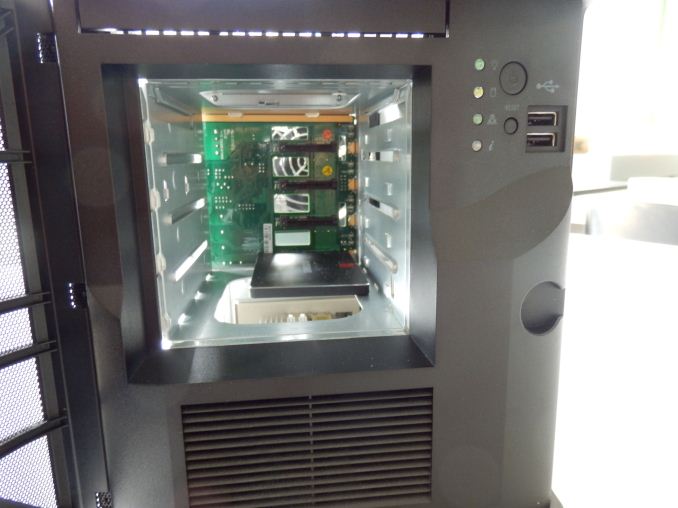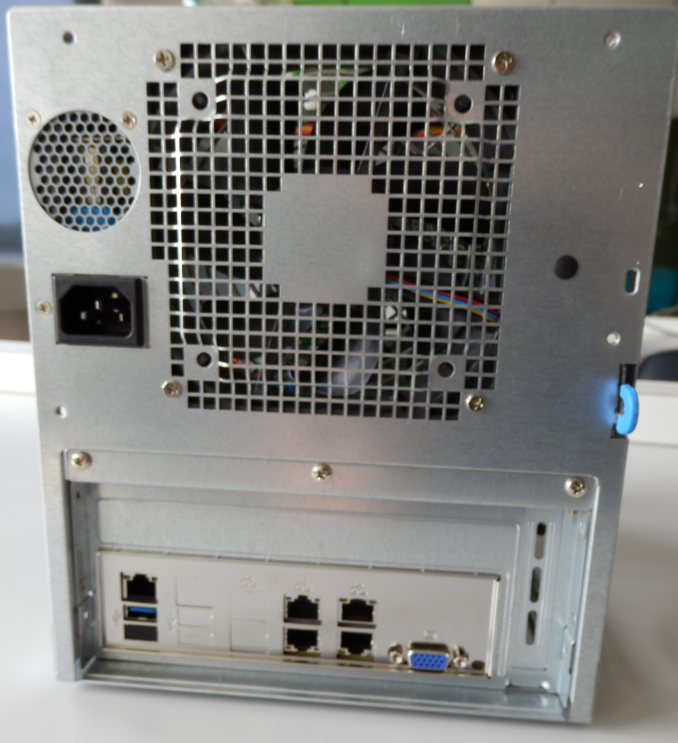The Intel Xeon D Review: Performance Per Watt Server SoC Champion?
by Johan De Gelas on June 23, 2015 8:35 AM EST- Posted in
- CPUs
- Intel
- Xeon-D
- Broadwell-DE
Supermicro's SuperServer 5028D-TN4T
Supermicro has always been one of the first server vendors that integrates new Intel technology. The Supermicro SYS-5028D-TN4T is a mini-tower, clearly targeted at Small Businesses that still want to keep their server close instead of in the cloud, which is still a strategy that makes sense in quite a few situations.
The system features four 3.5 inch hot swappable drive bays, which makes it easy to service the component that fails the most in a server system: the magnetic disks.
That being said, we feel that the system falls a bit short with regards to serviceability. For example replacing DIMMs or adding an SSD (in one of fixed 2.5 inch bays) requires you to remove some screws and to apply quite a bit of force to remove the cover of the chassis.
Tinkering with DIMMs under the storage bays is also a somewhat time consuming experience. You can slide out the motherboard, but that requires to remove almost all cabling. Granted, most system administrators will rarely replace SSDs or DIMMs. But the second most failing component is the PSU, which is not easy swappable either but attached with screws to chassis.
On the positive side, an AST2400 BMC is present and allows you to administer the system remotely via a dedicated Ethernet interface. Supermicro also added an Intel i350 dual gigabit LAN controller. So you have ample networking resources: one remote control ethernet port, two gigabit and two 10 gigabit (10GBase-T) ports, courtesy of the Xeon-D integrated 10 GbE Ethernet MAC.













90 Comments
View All Comments
Krysto - Tuesday, June 23, 2015 - link
Betteridge law.Metaluna - Tuesday, June 23, 2015 - link
...fails in this case. Did you read the review?CajunArson - Tuesday, June 23, 2015 - link
While desktop Broadwell isn't all that great, these server parts really show off Intel's accomplishments in improving power efficiency and performance-per-watt with 14nm.ARM has a huge hill to climb to really compete with these parts, and we've already seen AMD effectively skip its first iteration of an ARM product because they probably got wind of the Xeon D and decided they would have to do both a die-shrink and completely customized ARM core just to keep up.
The_Assimilator - Tuesday, June 23, 2015 - link
I very much doubt whether we'll ever see another server CPU from AMD, regardless of ARM cores or not. If they even manage to get Zen out the door, *and* it's not another massive flop, I will be impressed.Refuge - Tuesday, June 23, 2015 - link
I root for them everyday, but lets not give them too big of a hill to climb with a broken leg now. lolextide - Tuesday, June 23, 2015 - link
Take it easy man, AMD is not going down the drain any time soon, and we WILL see some future server oriented parts come from them. But how fast will they be? That's the question and we wont know for a while...Kjella - Tuesday, June 23, 2015 - link
Really? Last quarter they had a $187 million total comprehensive loss on $1030 million in revenue, even if you exclude the restructuring cost they lost $100 million for a -10% deficit. The stockholder's equity is almost gone with $17 million left, after that getting funding or a credit limit will become much harder.And Q2 is probably going to be another bloody quarter with no major CPU or GPU launches and firesales of old Win8 stock in preparation for Win10. The console ramp-up is usually in Q3 in preparation for Christmas, not before the summer. Last quarter's loss they took almost entirely from their cash reserves, they're now in the lower end of what they need to operate, if they lose this quarter too they must cut where it hurts bad.
Guspaz - Tuesday, June 23, 2015 - link
When we needed a low-power and low-cost server solution, we went with a desktop i3, because for some reason Intel supports ECC RAM on the i3 and lower, but not in the i5 and higher.julianb - Tuesday, June 23, 2015 - link
Very interested in this SOC.If possible could we see how the Xeon D deal with Cinebench Multithreaded test?
I am into 3D CPU rendering and would like to know how does the Xeon D-1540 compare to say i7-3930K or i7-4790K.
I realize the purpose of Xeon D-1540's existence is different but still...
Thank you.
MrSpadge - Saturday, June 27, 2015 - link
An eco-tuned 5820K seem better. I don't suppose you're going to render 24/7 all the time, so the electricity savings from the 14 nm Broadwell will have a hard time making up for the massive difference in initial cost.